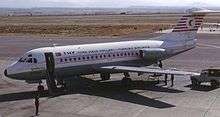Turkish Airlines Flight 345
 TC-JAP, the aircraft involved in the accident, photographed on 1 January 1975. | |
| Accident summary | |
|---|---|
| Date | 30 January 1975 |
| Summary | Impacted Sea of Marmara during go-around |
| Site |
Sea of Marmara, Turkey 40°44′50″N 28°39′58″E / 40.7472°N 28.666°ECoordinates: 40°44′50″N 28°39′58″E / 40.7472°N 28.666°E |
| Passengers | 38 |
| Crew | 4 |
| Fatalities | 42 (all) |
| Survivors | 0 |
| Aircraft type | Fokker F28-1000 Fellowship |
| Aircraft name | Bursa |
| Operator | Turkish Airlines |
| Registration | TC-JAP |
| Flight origin | Izmir Cumaovası Airport, Turkey |
| Destination | Istanbul Yeşilköy Airport, Turkey |
Turkish Airlines Flight 345 was a scheduled domestic passenger flight operated by a Fokker F28-1000 Fellowship from Izmir Cumaovası Airport to Istanbul Yeşilköy Airport that crashed into the Sea of Marmara on 30 January 1975 during the approach to its destination.[1]
It was the second worst accident involving a Fokker F28 and third deadliest aviation accident in Turkey at that time.[1]
Background
The aircraft operating flight 345 was a Fokker F28 Fellowship 1000 powered by two Rolls-Royce RB183-2 "Spey" Mk555-15 turbofan jet engines. It was built by Fokker with manufacturer serial number 11058 and made its first flight in 1972. Since then, it accumulated 3713 flying hours in 5062 cycles.[1] With 38 passengers and 4 crew members on board, flight 345 took off from Izmir Cumaovası Airport at 18:00 local time for a 40-minute flight to Istanbul Yeşilköy Airport.[2]
Accident
At 18:39, the aircraft touched down on the runway at Istanbul Yeşilköy Airport but an electrical power failure at the airport at that very moment forced the crew to initiate a missed approach. Twenty-two seconds after the lights went off, the emergency generator jumped in and restored the runway lights. The pilot elected to remain VFR under a variable ceiling of 240 m (790 ft). At 18:43, the crew asked for permission to land while positioning for another approach. However, because another aircraft, a Pan American World Airways Boeing 747, was about to take off, air traffic control ordered the crew of flight 345 to fly an extended downwind leg. When, at 18:53, air traffic control attempted to establish contact with flight 345, it received no answer.[2]
It was determined that the aircraft crashed into the Sea of Marmara. However, the wreckage could not be located until several years later.[3]
Recovery
The relatives of the victims continuously demanded without success the recovery of the wreckage and the bodies of the victims from the sea floor.[3] A 3 m (9.8 ft) by 3 m (9.8 ft) 200 kg (440 lb) portion from the rear fuselage with five window frames was recovered on March 17, 2009 by shrimp trawling fishermen off the Avcılar-Florya coast. The finding was handed over to Turkish Airlines[4] after inspection by Stuart Kline, an American historian of aviation living in Turkey.[5]
References
- 1 2 3 "Aircraft accident Fokker F-28 Fellowship 1000 TC-JAP Istanbul-Yeşilköy Airport (IST) [Marmara Sea]". Aviation Safety Network. Retrieved 2009-10-03.
- 1 2 "Kara kutunun peşinde 36 yıl" (in Turkish). Sabah. Retrieved 4 June 2014.
- 1 2 "Korkunç iddia! Stuart Kline; Devlet ‘sus payı’ alarak kazanın üzerini örttü! THY derhal yanıtla ve çıkart!" (in Turkish). Hürriyet Port. 2009-06-15. Archived from the original on 2014-06-04.
- ↑ "35 Yıllık Kalıntı Günyüzüne Çıktı" (in Turkish). Deniz Haber. Retrieved 2009-10-03.
- ↑ "Tarihi uçak balıkçı ağına takıldı" (in Turkish). Haber 24. 2009-03-18. Archived from the original on 2014-06-04.
| ||||||